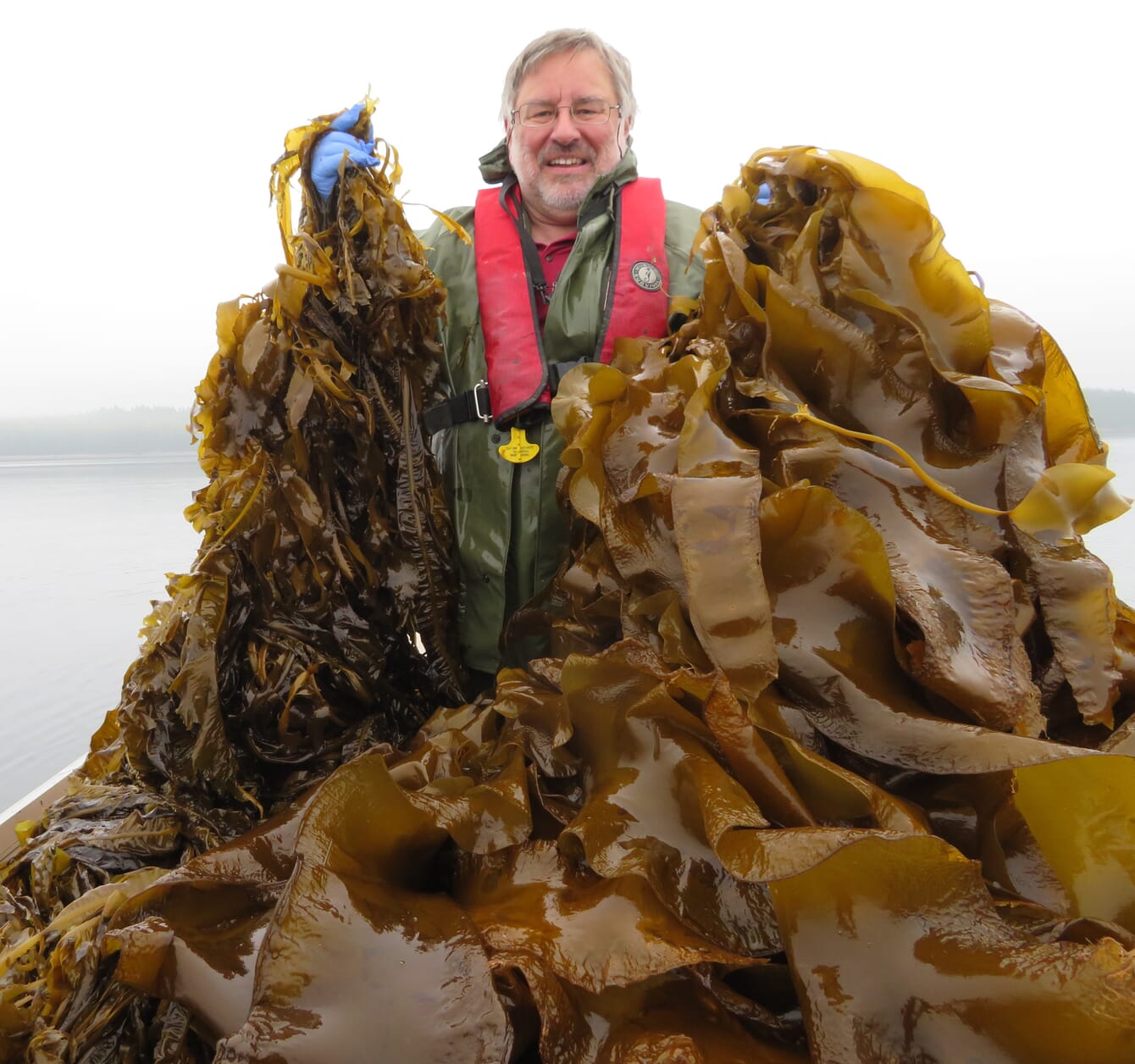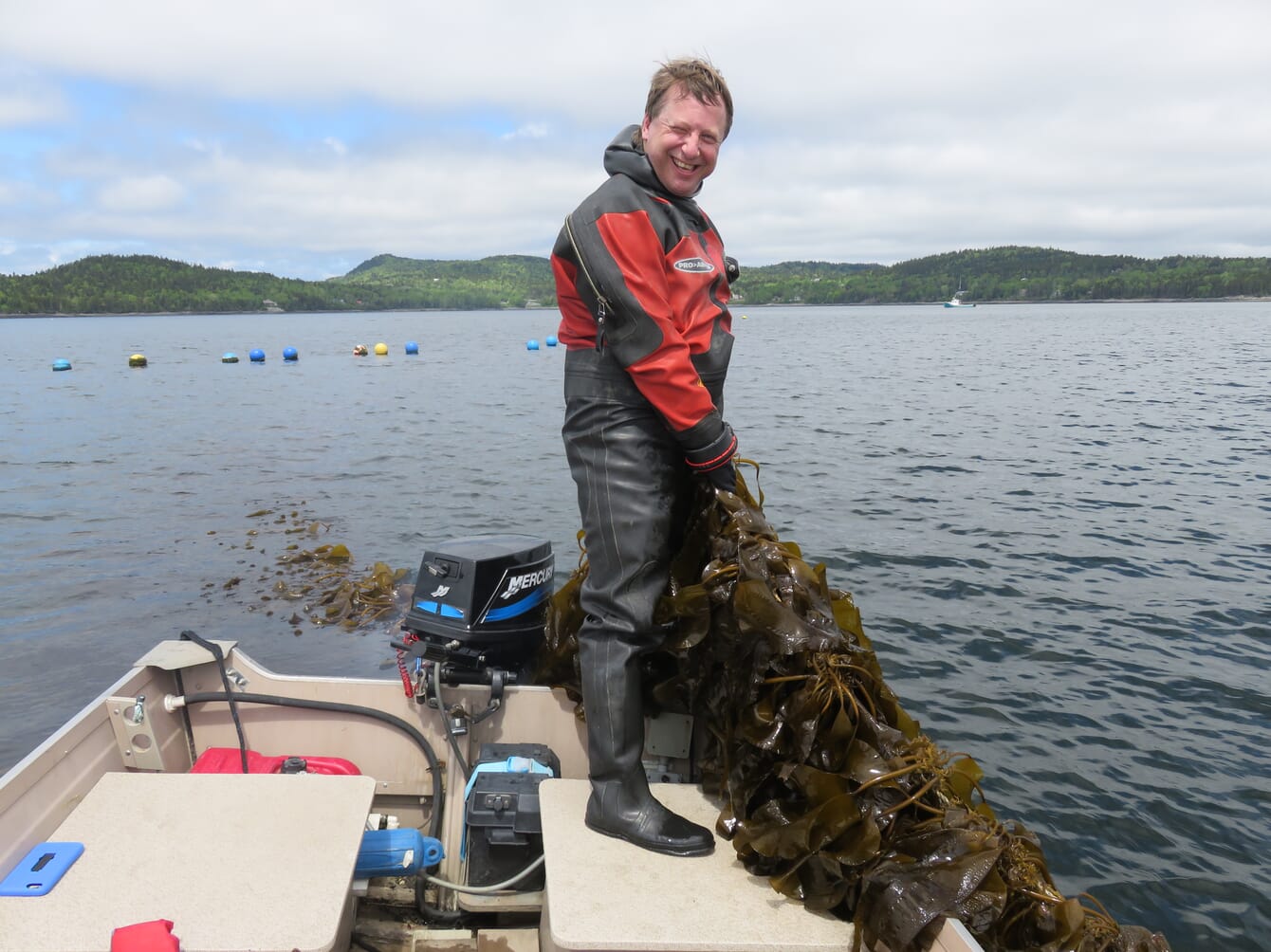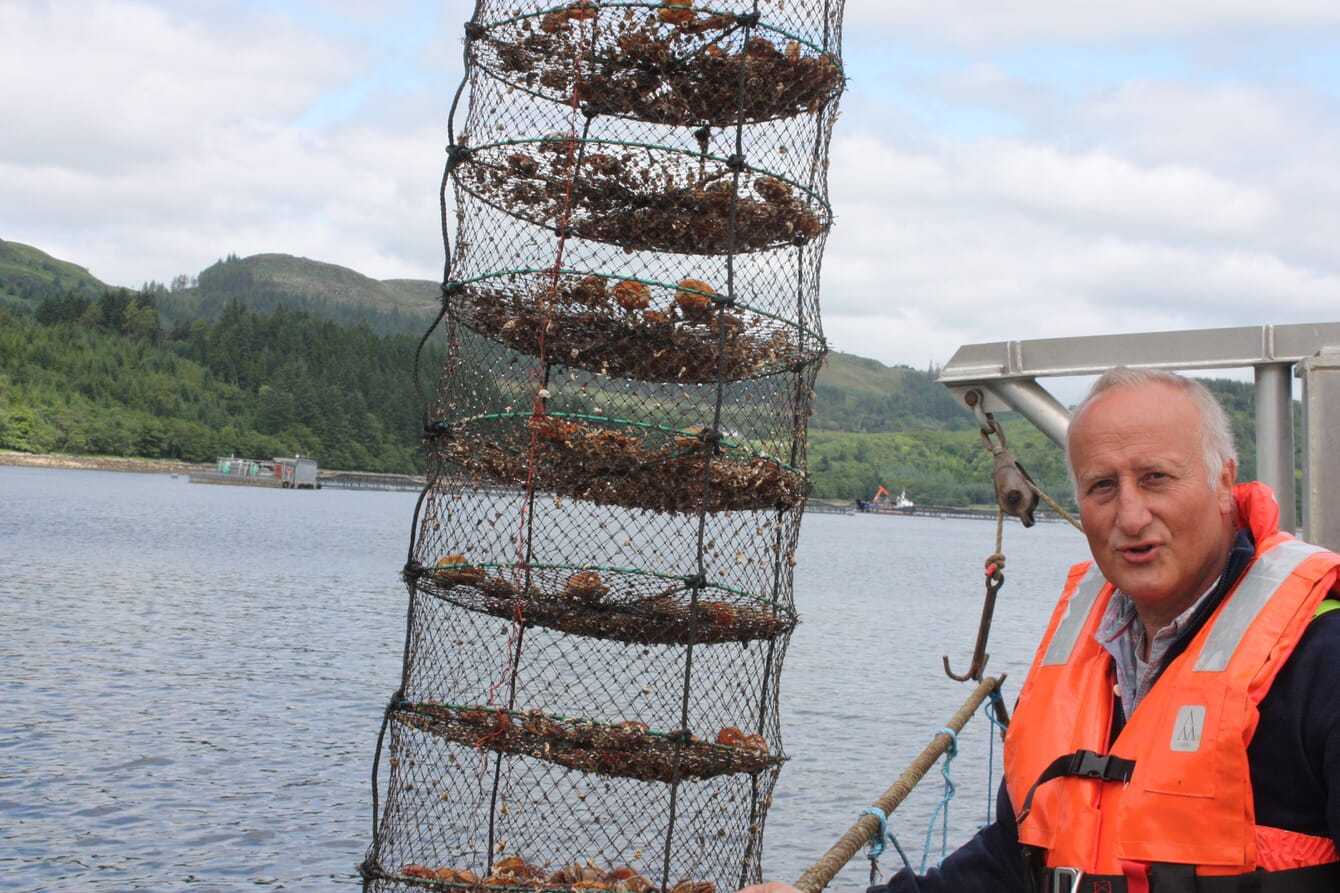
Here he is holding sugar kelp (Saccharina latissima) on the right and winged kelp (Alaria esculenta) on the left. Both species are cultivated at the Magellan Aqua Farms site in the Bay of Fundy, New Brunswick, Canada. © Steve Backman
Referred to by some as polyculture 2.00, integrated multi-trophic aquaculture (IMTA) identifies and uses natural processes to simultaneously break down wastes, produce diversified crops and provide a host of benefits for both people and the planet.
Take, for example, a large fish farm in southern Israel, where mullet, sea cucumbers, bivalves and mangroves are grown in-sync. While the mullet and sea cucumbers eat uneaten feeds, mussels actively filter particulate matter, and the mangroves and other plants absorb excess nutrients from the water.
It’s a win-win situation that ensures a large portion of the nitrogen and phosphorus from feeds are either assimilated by animals like fish and bivalves that can be profitably sold, or organisms like mangroves which provide other tangible benefits.
Mangrove forests, for instance, not only provide habitats for many organisms and store up to five times more carbon than most tropical forests – their ecosystem services can also be used to offset carbon and carbon trading taxes, making IMTA operations more cost-competitive in a world fast embracing the concept of decarbonisation.
The Fish Site recently had the honour of speaking with IMTA’s principal proponent, Dr Thierry Chopin, to discuss the ongoing IMTA revolution. Chopin and his colleague Jack Taylor introduced IMTA to the world in 2004 and he provides key insights into lessons learned over the past two decades and how he sees the future of IMTA.
Starting out with seaweeds
Dr Chopin grew up in France and obtained his doctorate from the University of Western Brittany. As an ecophysiologist and biochemist, his research focused on the relation between the production of phycocolloids, such as carrageenans produced by red seaweeds, and the availability of nutrients in seawater.
He immigrated to Canada in 1989 and soon thereafter became interested in aquaculture, particularly the role that seaweeds actively play in biofiltration by utilising the excess nutrients produced by salmon cages. His passion eventually led him to develop the concept of IMTA.
He is a professor with the department of biological sciences of the University of New Brunswick in Saint John, as well as the director of The Seaweed and Integrated Multi-Trophic Aquaculture (IMTA) Research Laboratory. He is also the past president of the Aquaculture Association of Canada, the Phycological Society of America and the International Seaweed Association.
In addition, Dr Chopin created his own company, Chopin Coastal Health Solutions Inc., in 2016, and is also an honorary consul of France.
IMTA: embracing nature’s systems
Back in 2004, Dr Chopin, Amir Neori and a number of other colleagues published one of their first and most critical papers on integrated aquaculture, outlining the rationale and evolution of using seaweeds as biofilters for marine aquaculture. By February 2021, the article reached the significant milestone of being cited 1,000 times in the papers of other researchers.
Chopin describes IMTA as: “The farming, in proximity, of aquaculture species from different trophic levels with complementary ecosystem functions, in a way that allows one species' uneaten feed, waste, nutrients and by-products to be recaptured and converted into fertiliser, feed and energy for other crops, and to take advantage of interactions between species. Farmers combine fed aquaculture (eg finfish) with synergistic extractive aquaculture, which utilises the inorganic (eg micro- and macro-algae and plants) and organic (eg suspension and deposit feeders) excess nutrients from fed aquaculture for their growth. What were previously considered wastes, or by-products, of one species become co-products that can be used by other species, considered additional crops, providing economic diversification in more efficient and responsible food production systems. This is biomimicry, simply emulating what nature does.”
By culturing fish with filtering species like seaweeds and bivalves, water quality is improved. Additional research from Canada shows that seaweeds and mussels benefit from being cultured near salmon farms, with up to 46 percent higher growth rates compared to monocultures.
Over the past decade, IMTA has become accepted by both the scientific community and the private sector as a means to produce extra food while minimising waste.
“Being cited over 1,000 times attests to the validity of the IMTA concept,” argues Chopin.
Optimisation, integration and cooperation
Dr Chopin’s ideas and experiments initially started out with salmon, kelps and mussels – the most logical species to focus on in eastern Canada. However, he repeats the need to diversify the composition of IMTA systems to optimise yields in various waters and regions.
As recently highlighted by FAO, embracing native species and keeping production systems diverse allows farm operators to follow a more ecologically-sound approach with better resilience to risks like disease outbreaks and climate change. Moving away from monoculture and adapting more natural multi-trophic farming systems is a fundamental part of IMTA.

After decades of field experience, Dr Chopin concludes that IMTA systems are best suited for small and medium-sized companies who work more closely with local communities, and which have more autonomy to decide their own operational practices, compared to large commodity operations, where shareholders focus solely on the short-term financial bottom line.
Dr Chopin continuously reiterates that IMTA is a concept, not a formula, and is dependent on constant research on different species and combinations. For example, since mussels reject organic particles larger than 100 microns, adding sea urchins and sea cucumbers greatly improves the filtration capacity of the larger organic particles, while generating a more diverse product mix.
Integration and close cooperation are also crucial: Dr Chopin points out that, in Canada, lobster fishers and salmon farmers can compete for space, despite the fact that salmon farms are excellent nurseries for juvenile lobsters. By teaming up, both parties stand to benefit from higher yields, not to mention more cordial conversations on the wharf.
Chopin also realised that farmers are rarely equally good at raising fish, invertebrates and seaweeds, and should primarily stick to their own areas of expertise. These farmers should then work closely to coordinate their activities.
There has been a lot of misunderstanding when talking of “cultivation in proximity” Chopin explains.
“We started with salmon, mussels and kelps grown within the limits of a salmon farm because we had to operate within the regulations in place in Canada at that time. However, this does not reflect the ecosystem scales at which aquaculture farms really function,” he notes.
Because the different types of nutrients disperse at different spatial and temporal scales in the environment, different recapture strategies need to be designed. The “integrated” in IMTA should be understood as cultivation in proximity, not considering absolute, and often arbitrary, distances (500 metres, one kilometre or five kilometres are the common ones), but considering the connectivity of water bodies and sediments in terms of ecosystemic functionalities. This means that the different components of an IMTA system do not have to be right at the same location, but that entire bays or regions could be the units of IMTA management, within an integrated coastal area management (ICAM) strategy.
Chopin mentions that fish monoculture farms in the coastal zone and freshwater habitats could be phased out by legislators in the near future, so it’s a good move for investors to start reconsidering their placements in old-school farming systems. This is where IMTA comes in.
IMTA requires well-planned farming operations that prevent expensive and publicly-damaging conflicts with other coastal zone users. A Canadian study on IMTA salmon farming systems found that participants felt that IMTA reduced the environmental impacts of salmon farming while benefitting local communities.
All participants strongly believed that seafood produced via IMTA is safe to eat, with half of all participants willing to pay a premium for products labelled as such. Employing IMTA systems may thus reduce investor exposure to both reputational and financial risks.
IMTA roadblocks
1. Overly stiff regulations
Salmon, at least for the Western world, is still the dominant species cultured in marine waters. For many countries, including Canada and Norway, aquaculture legislation has been built around salmon farms, particularly to combat diseases in intensive monocultures. It’s now, however, clear that these regulations may inadvertently prevent innovation in aquaculture practices.
In Canada, for instance, regulators have developed fallowing systems for salmon farmers. Every two years, aquaculture sites must be cleared to allow time to recover. However, why should bioremediating organisms like bivalves also be removed from the sites? What would be the incentive for a farmer to throw away tonnes of sea scallop before they reach commercial sizes?
Regulators tend to focus on applying rules precisely within the boundaries of a leased area.
“Regulators must understand that they need to adjust and take a more holistic or ecosystem-based approach, which accounts for the interactions between the various species and the various companies, their stakeholders and other inhabitants of coastal zones,” explains Chopin.
Natural processes simply can’t be confined to the four buoys of a leased area. Thus, legislators should be a bit more perceptive and adaptable, like Mother Nature herself, he suggests.
2. Calculating true costs, prices and values
According to Dr Chopin, large salmon farmers continue to focus on the bottom line: financial returns for operators and investors. As externalities aren’t taken into account and internalised, these practices continue to prop up a false economy. The large salmon companies are making good money, so why change? As they aren’t pressured to do so, they continue to offload environmental impacts onto their communities, stakeholders and future generations, he argues.
Dr Chopin and his colleagues have published 11 papers on the economic value and benefits of IMTA. They all demonstrated that IMTA is more profitable than conventional fish (salmon) monoculture in the long term.
“They are all based on numbers provided by the aquaculture industry, so you wonder why they do not accept them readily and adopt IMTA more rapidly,” notes Dr Chopin. They were also able to sell salmon produced in IMTA farms with an 11 percent price premium at the leading food retailer in Canada.
We believe that real pricing can play a valuable role in the coming years. Younger generations are more receptive to sustainability and transparency in supply chains. The Netherlands, for example, have developed the True Price Initiative, which calculates the costs associated with environmental pollution, inequitable working conditions, plus other factors.
More carbon or labour-intensive products are displayed on shelves with their retail prices, along with their true prices, which can be 20 percent or so higher than their retail tags. Buyers are given the option to voluntarily pay for the true price of goods. This is already being done for commodities like chocolate, bananas and coffee.
If the same can be done for salmon, then IMTA-produced salmon would be preferable to regular salmon from intensive farms, which don’t integrate environmental impacts in their costs of production.
More importantly, this approach makes society rethink the blind importance we place on money and financial returns without considering environmental impacts, rather than taking a holistic view of what’s good. Doing so allows us to better generate nutritious and equitably-produced food.
Chopin insists that to calculate the full value of IMTA, it is important to stop valuing extractive species only for their biomass as food trading goods, but also for the vital ecosystem services they provide. For example, seaweeds provide nutrient biomitigation, which can be valued for the worldwide seaweed aquaculture production (32.4 million tonnes) at between $1.2 billion and $3.5 billion, which is as much as 26.2 percent of its present commercial value ($13.3 billion).
While people focus on carbon trading taxes, Chopin thinks we should also develop the concept of nutrient trading credits (NTC), for the recovery of nitrogen and phosphorus in particular. This can then earn much higher returns than carbon trading credits.
The recognition and implementation of NTC would give a fair price to extractive aquaculture. They could be used as financial and regulatory incentive tools to encourage single species aquaculturists to contemplate IMTA as a viable alternative to their current practices.
Short project cycles
Research projects usually span four years, which means proponents spend the first year getting to know each other, the second year realising that they need to standardise their methods to get meaningful comparisons, the third year collecting useful data, and the fourth year wrapping up and writing a report.
According to Chopin, this compressed cycle is simply too short for meaningful data acquisition, analysis and transfer / dissemination to the industry, regulators and the general public for implementation. To really progress from research, to development, to commercialisation, well-strategized plans should span decades to see the committed adoption of innovative practices.

The future of IMTA
Aside from increased public awareness on true pricing, diversified stock mixes and better practices and technology, IMTA should accompany two current trends in the sector – moving offshore and moving on land. If many companies move offshore, it will become a busy place and nutrients will soon become an issue there – as we learned from fisheries, the ocean is not as immense as we once thought.
If salmon hatcheries also become juvenile rearing facilities for longer periods of time, they will generate larger nutrient waste streams, which will need to be treated. With phosphorus being the main issue in freshwater (instead of nitrogen in the marine environment), the present strategy is to chemically precipitate it to obtain a sludge, which is collected by disposal companies, making money at both ends, as companies turn the sludge into compost. Chopin believes that fish hatcheries can adopt IMTA principles by diversifying operations with aquaponics, turning wastes into co-products generating additional crops and revenues.
There are many applications of the IMTA concept, which is flexible and evolving, that can be applied worldwide in open-water or land-based systems, marine or freshwater environments and temperate or tropical climates. To ride the wave of the future, today’s farmers should start experimenting with these approaches now.
There is no ultimate IMTA system to feed the world. If the IMTA concept is intentionally extremely broad, a more granular approach is needed to identify the design of the best-suited IMTA system for a particular region. Different native species and different climatic, environmental, biological, physical, chemical, economic, historical, societal, political and governance conditions will obviously lead to different choices.
As Chopin explains: “The man who developed the Toyota Prius in 1993 became Toyota’s chief engineer in 2005. He knows how new technology takes time to be accepted. He now envisions that electric and hydrogen fuel cell cars will become the world’s predominant cars, but only by 2050.”
Chopin is realistic too. “We are still in the infancy of western IMTA. The adoption of IMTA will not happen overnight, especially in the western world, which presently prefers monocultures, linear processes and short-term profits. We will need patience, determination and persistence to get people to see the environmental, economic and societal advantages of growing complementary species together, creating circular economy processes and seeking sustainability in the long term.”




